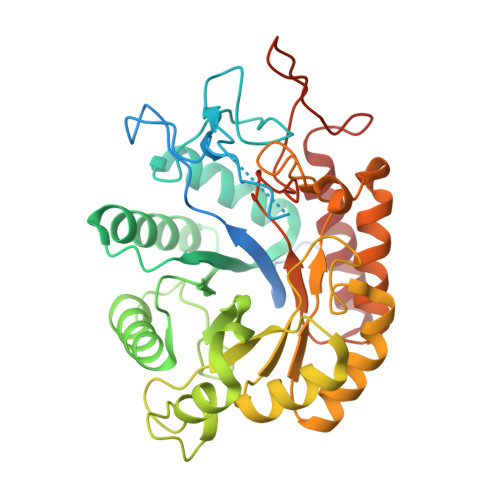An Epoxide Intermediate in Glycosidase Catalysis.
Sobala, L.F., Speciale, G., Zhu, S., Raich, L., Sannikova, N., Thompson, A.J., Hakki, Z., Lu, D., Shamsi Kazem Abadi, S., Lewis, A.R., Rojas-Cervellera, V., Bernardo-Seisdedos, G., Zhang, Y., Millet, O., Jimenez-Barbero, J., Bennet, A.J., Sollogoub, M., Rovira, C., Davies, G.J., Williams, S.J.(2020) ACS Cent Sci 6: 760-770
- PubMed: 32490192
- DOI: https://doi.org/10.1021/acscentsci.0c00111
- Primary Citation of Related Structures:
6FWG, 6FWI, 6FWJ, 6FWL, 6FWM, 6FWO, 6FWP, 6FWQ - PubMed Abstract:
Retaining glycoside hydrolases cleave their substrates through stereochemical retention at the anomeric position. Typically, this involves two-step mechanisms using either an enzymatic nucleophile via a covalent glycosyl enzyme intermediate or neighboring-group participation by a substrate-borne 2-acetamido neighboring group via an oxazoline intermediate; no enzymatic mechanism with participation of the sugar 2-hydroxyl has been reported. Here, we detail structural, computational, and kinetic evidence for neighboring-group participation by a mannose 2-hydroxyl in glycoside hydrolase family 99 endo -α-1,2-mannanases. We present a series of crystallographic snapshots of key species along the reaction coordinate: a Michaelis complex with a tetrasaccharide substrate; complexes with intermediate mimics, a sugar-shaped cyclitol β-1,2-aziridine and β-1,2-epoxide; and a product complex. The 1,2-epoxide intermediate mimic displayed hydrolytic and transfer reactivity analogous to that expected for the 1,2-anhydro sugar intermediate supporting its catalytic equivalence. Quantum mechanics/molecular mechanics modeling of the reaction coordinate predicted a reaction pathway through a 1,2-anhydro sugar via a transition state in an unusual flattened, envelope ( E 3 ) conformation. Kinetic isotope effects ( k cat / K M ) for anomeric- 2 H and anomeric- 13 C support an oxocarbenium ion-like transition state, and that for C2- 18 O (1.052 ± 0.006) directly implicates nucleophilic participation by the C2-hydroxyl. Collectively, these data substantiate this unprecedented and long-imagined enzymatic mechanism.
Organizational Affiliation:
York Structural Biology Laboratory, Department of Chemistry, University of York, York YO10 5DD, United Kingdom.



















